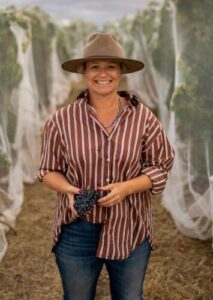This issue’s Technical Note focuses on the results of recent work in identifying typical values for fats, proteins and salt in Australian wines that will assist Australian producers with new European Union wine labelling changes for wines produced after 8 December 2023.
Read the latest publications on alternative packaging such as cans and lighter bottles, saving energy on winery refrigeration, comsumer reponse to wine made from smoke-affected grapes, and using organic mulches as an alternative for under-vine weed management.
Australian winemakers and grapegrowers who pay the Wine Grapes or Grape Research levies can log in to read abstracts and order the latest non-open access journal articles from the AWRI Library, free of charge. Register a new login or use the forgotten password link to reset your password.
We welcome your feedback on Technical Review and you can reach us at infoservices@awri.com.au.
Below is a snapshot of what’s in this issue.
Technical Note
Typical values for fats, proteins and salt in Australian wine for nutritional labelling
AWRI Publications
- Alternative packaging and wine: Should we move beyond the green bottle? [Request copy from AWRI Library] Wine & Viticulture Journal
- Ask the AWRI: Does having thick skin pay off when it comes to measuring sugar in grapes? [Read full-text online] Australian & New Zealand Grapegrower & Winemaker
- Ask the AWRI: Gases – we have you covered [Read full-text online] Australian & New Zealand Grapegrower & Winemaker
- Consumer response to wine made from smoke-affected grapes [Request copy from AWRI Library] Wine & Viticulture Journal
- Enhancing the sensory properties and consumer acceptance of warm climate red wine through blending [Read full-text online] OENO One
- Metagenomic ecosystem monitoring of soft scale and mealybug infestations in Australian vineyards [Read full-text online] bioRxiv
- Trialling autonomous under-vine weed management in Australian vineyards [Request copy from AWRI Library] Australian & New Zealand Grapegrower & Winemaker
- Understanding consumers’ perceptions of smoke-affected wines [Read full-text online] IVES Technical Reviews: Wine & Vine
- Understanding the costs and benefits of producing a wine-grape crop in low market demand years [Request copy from AWRI Library] Australian & New Zealand Grapegrower & Winemaker
- Vintage 2023 – observations from the AWRI helpdesk [Read full-text online] Wine & Viticulture Journal
Oenology
- Colour properties and tannin concentrations of polymeric phenolic materials extracted from Pinot noir wines of a single NZ producer [Read full-text online] International Journal of Food Science & Technology
- Exploring the effect of ripening rates on the composition of aroma and phenolic compounds in Cabernet Sauvignon wines [Read full-text online] Internet Journal of Viticulture and Enology
- High-temperature drying of red grape pomace: Effects on the polyphenolic composition of skins and seeds [Read full-text online] Internet Journal of Viticulture and Enology
- Adaptive cooling control: Improved version of pulse cooling provides greater energy efficiencies [Request copy from AWRI Library] Australian & New Zealand Grapegrower & Winemaker
- Birth of the cool: Innovation in winery air conditioning systems [Request copy from AWRI Library] Australian & New Zealand Grapegrower & Winemaker
- Towards net zero in the winery [Request copy from AWRI Library] Wine & Viticulture Journal
- Creating cleaner, taint-free natural corks [Request copy from AWRI Library] Australian & New Zealand Grapegrower & Winemaker
- Migration of polyphenols from natural and microagglomerated cork stoppers to hydroalcoholic solutions and their sensory impact [Read full-text online] Oeno One
- Packaging of wine in aluminum cans – a review [Read abstract online] [Request copy from AWRI Library] American Journal of Enology and Vititculture
- Switching to lighter bottles: The beneficial domino effect for wineries [Read full-text online] Wine Business Monthly
- Mouthfeel subqualities in wines: A current insight on sensory descriptors and physical-chemical markers [Read full-text online] Comprehensive Reviews in Food Science and Food Safety
- Sensory and aroma impact of mitigation strategies against sunburn in Riesling [Read full-text online] OENO One
- Having a drink with awkward Brett: Brettanomyces, taste(s) and wine/markets [Read full-text online] New Zealand Geographer
- Impact of smoke from wheat, oat, and clover stubble burning on cabernet sauvignon grapes and wine [Read full-text online] Australian Journal of Grape and Wine Research
- Does bunch or berry size matter? [Read full-text online] New Zealand Winegrower
- Exploring the winemaker’s arsenal: Options for gases, additives and skin contact [Request copy from AWRI Library] Australian & New Zealand Grapegrower & Winemaker
- The technology of high-power ultrasound and its effect on the color and aroma of Rosé wines [Read full-text online] Journal of the Science of Food and Agriculture
- Wine acidification methods: A review [Read full-text online] OENO One
Sustainability
- Biochar from grapevine pruning residues as an efficient adsorbent of polyphenolic compounds [Read full-text online] Materials
- Developing a sustainability vision for the global wine industry [Read full-text online] Sustainability
- Questioning the business model of sustainable wine production: The case of French “Vallée du Rhône” wine growers [Read abstract online] [Request copy from AWRI Library] Journal of Cleaner Production
Viticulture
- Thwarting the threat of winter frosts: What an approaching El Nino climate event may mean for winegrowers [Request copy from AWRI Library] Australian & New Zealand Grapegrower & Winemaker
- Future climate and the impact on wine: Predictable or uncertain? [Read full-text online] The World of Fine Wine
- Future scenarios of bioclimatic viticulture indices in the Eastern Mediterranean: insights into sustainable vineyard management in a changing climate [Read full-text online] Sustainability
- Factors influencing Pinot noir berry weight and resulting wine quality [Read full-text online] New Zealand Winegrower
- How to better estimate bunch number at vineyard level? [Read full-text online] Oeno One
- Brand new breeds [Read full-text online] New Zealand Winegrower
- Consumer acceptance of fungus-resistant grape varieties – An exploratory study using sensory evaluation tests among consumers in Germany [Read full-text online] Sustainability
- New findings and actions in the recovery of old Mediterranean grapevine varieties [Read full-text online] Vitis
- Saline-alkaline stress resistance of Cabernet sauvignon grapes grafted on different rootstocks and rootstock combinations [Read full-text online] Plants
- Management of grapevine trunk disease using remedial surgery [Read full-text online] New Zealand Winegrower
- Susceptibility of grapevine sucker and green shoot wounds to trunk disease pathogens [Read full-text online] South African Journal of Enology and Viticulture
- Tech development aids phylloxera detection [Request copy from AWRI Library] Australian & New Zealand Grapegrower & Winemaker
- Variation in susceptibility to Downy mildew Infection in Spanish minority vine varieties [Read full-text online] Plants
- Influence of the application of charred and uncharred spent coffee grounds on soil carbon and nitrogen cycles [Read abstract online] [Request copy from AWRI Library] Archives of Agronomy and Soil Science
- Organic mulches as an alternative for under-vine weed management in Mediterranean irrigated vineyards: Impact on agronomic performance [Read full-text online] European Journal of Agronomy
- An operational model for capturing grape ripening dynamics to support harvest decisions [Read full-text online] OENO One
- Delay in the ripening of wine grapes: Effects of specific phytotechnical methods on harvest parameters [Read full-text online] Agronomy
- Best procedures for leaf and stem water potential measurements in grapevine: Cultivar and water status matter [Read full-text online] Plants



